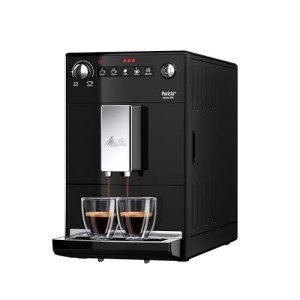The Art of Italian Espresso Machines: A Brewed Tradition
Italian espresso machines are not simply appliances; they are an important part of Italy's abundant coffee culture, representing a mix of artistry, engineering, and style. Coffee fanatics around the world recognize the value of high-quality espresso, a staple of Italian life and food. This short article explores the history, mechanics, types, and aspects to think about when purchasing an Italian espresso machine, reflecting the depth of this precious beverage and its brewing methods.
History of Espresso Machines
The espresso machine's advancement dates back to the early 20th century in Italy, where coffee was not simply a beverage but a necessary social routine. The preliminary attempts to brew espresso begun with easy, stove-top models, slowly developing into intricate machines that might reproduce the best brew.
- 1901-- The First Espresso Machine: The very first steam-powered espresso machine, known as the "Ideale," was developed by Luigi Bezzera. This equipment marked a turning point in espresso brewing.
- 1938-- The Lever Machine: The introduction of the lever machine made it simpler to control the pressure used in espresso extraction, enhancing taste consistency.
- 1947-- The Automatic Machine: Reaching more customers, Gaggia released the first automatic espresso machine, more popularizing espresso bars.
- 2007-- The Digital Age: Technological advancements led to the birth of fully programmable machines, enabling users to customize their brewing settings to attain an individualized coffee experience.
Key Features of Italian Espresso Machines
Italian espresso machines embody accuracy, craftsmanship, and innovation. Here are some crucial parts that highlight their significance:
| Feature | Description |
|---|---|
| Boiler Type | Figures out how heat is generated and kept. Typical types consist of single boiler, dual boiler, and heat exchanger. |
| Group Heads | Where the coffee is brewed; commercial machines typically have multiple group heads for effectiveness. |
| Pressure Control | Vital for accomplishing the ideal espresso; most machines operate at 9 bars of pressure. |
| Frothing Capabilities | The steam wand enables milk frothing, vital for beverages like cappuccino and latte. |
| Construct Quality | The materials utilized (stainless steel, brass, and so on) influence resilience and heat retention. |
Kinds Of Italian Espresso Machines
Picking the right machine depends upon user choices, budget, and intended use. Below are the primary types of Italian espresso machines:
Manual Espresso Machines
- Pros: Offer full control over the brewing procedure, enabling a tailored touch.
- Cons: Require ability and practice, can be labor-intensive.
Semi-Automatic Machines
- Pros: Provide a balance between automatic and manual processes; users control water flow.
- Cons: Can have a steeper learning curve than completely automatic machines.
Fully Automatic Machines
- Pros: Simplify the brewing process with push-button operations; ideal for novices.
- Cons: May sacrifice a few of the subtleties of manual brewing.
Super-Automatic Machines
- Pros: Grind, tamp, brew, and froth immediately; practical for busy lifestyles.
- Cons: Less control over the brewing variables, capacity for a less authentic espresso experience.
Buying Guide: Factors to Consider
Selecting the ideal Italian espresso machine can be difficult, but considering the following factors can streamline the decision-making procedure:
- Budget: Italian espresso machines vary from affordable to high-end models, so set a budget upfront.
- Usage Frequency: Evaluate how frequently you will use the machine; everyday users might desire a more durable choice.
- Space: Measure your kitchen area or counter area; some machines can be large and require enough clearance.
- Upkeep: Consider ease of cleansing; machines with removable parts or built-in cleansing functions may lower maintenance.
- User Skill Level: Beginners might choose completely or semi-automatic machines, while skilled baristas can handle manual machines.
- Brand Reputation: Research brand names understood for quality, such as Breville, Gaggia, and La Marzocco.
Popular Italian Espresso Machine Brands
Italian workmanship is renowned for producing a few of the very best espresso machines worldwide. Here are top brands worth thinking about:
- Gaggia: Known for its home espresso machines and price.
- La Marzocco: An exceptional brand name known for its commercial-grade machines and ingenious technology.
- Rancilio: Renowned for its long lasting build and professional-quality machines suitable for home and commercial use.
- Sage/Breville: Offers advanced features and easy to use designs, ideal for both amateurs and lovers.
Frequently asked questions
What is the difference in between espresso and regular coffee?
Espresso is a concentrated coffee brewed by forcing hot water through finely-ground coffee under pressure. It has a thicker consistency, richer taste, and higher caffeine concentration than regular coffee.
Can I make milk-based beverages with an espresso machine?
Yes, many Italian espresso machines include a steam wand to froth milk for drinks like coffees, lattes, and macchiatos.
How typically should I clean my espresso machine?
Routine upkeep is vital. Normally, a comprehensive cleaning is recommended every couple of weeks, while descaling should be done every 1 to 3 months, depending on water hardness.
What is the ideal pressure for brewing espresso?
The ideal pressure for developing espresso is around 9 bars. This pressure guarantees the ideal extraction of tastes from the coffee premises.
Are more costly machines worth the financial investment?
Higher-end machines frequently use much better products and technology, offering enhanced resilience and more constant outcomes. For severe coffee lovers, investing in a great machine can elevate the espresso experience substantially.
Italian espresso machines are far more than mere brewing gadgets; they are an event of a cultural custom that has affected coffee usage worldwide. With Top Espresso Machines to fit any user's needs-- ranging from amateurs to skilled baristas-- there is an Italian espresso machine completely suited for everyone. As you start your espresso journey, understanding the history, mechanics, and options will enhance your experience and appreciation for this time-honored beverage. Whether you seek to recreate a café ambiance at home or improve your brewing strategy, these machines can delivering extraordinary cups of espresso embellished with the abundant history of Italian coffee culture.

